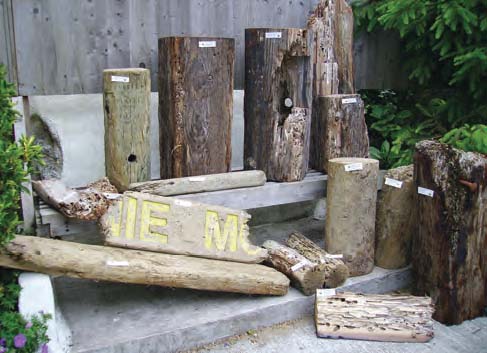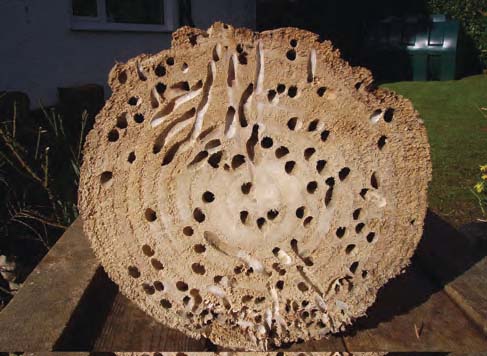Issue
17
Page
7
|
Of the 33 years that I have been collecting and recording the distribution of marine molluscs around Britain, 2007 has been the most extraordinary. I have always been mystified by some of the names that appear on the marine lists, names like Psiloteredo megotara, Bankia bipennata etc. and wondered why it was that I had never encountered such species and how I would recognise them if I did. From October 2006 and throughout 2007, my waiting has been rewarded with a vengeance. When I found my first piece of Shipworm timber at Pen-ychain near Pwllheli on the Lleyn Peninsula on 7/10/06, I was delighted. After the discovery of my second monster specimen of timber (10 ins, square by 8 feet long), at Church Bay in Anglesey on 11/12/06, I thought that all my birthdays had come at once, I was so delighted, I wrote an article for Mollusc World, “Traumas of Retrieving Shipworms”, which was published in Issue No. 13 in March 2007, little did I know then what was in store for the following year.
In February 2007, I received an email from Dr. Ivor Rees formerly of the Marine Sciences Dept. at Bangor University, Gwynedd, he informed me about a large piece of Shipworm timber which had been stranded at the mouth of the river Cefni in south west Anglesey. The log was positioned between the northern tip of Newborough Forest and the Bodorgan Estate on the other side of the river, two miles away from the nearest place where a car could be parked. Newborough Forest is a conservation area which Anglesey is proud of and I did not relish the idea of walking two miles through the forest armed with a bow saw, axe and hammer, so taking the cowards way out, I waited for low tide and waded out through the salt marshes and walked up the middle of the Malltraeth Bay. Although the bay does not drain completely I knew that the water is shallow and that the walking is firm and safe as I had done the journey before, I also knew that this way I would not encounter any bemused onlookers or angry Forestry Commission Officials.
The timber turned out to be a tree trunk 10 inches diameter by 12 feet long, it seemed that the specimens were getting larger and more remote and I felt at that time that I was being tested. After removing two sections from the log, one was carried in my rucksack and the other in a rope sling over my shoulder, at the end of the two mile journey back I realised that this was not the ideal way to retrieve timber. The remaining timber was removed in four journeys over the next few weeks using a back mounted carrying frame which I made out of an old shopping trolley, the exercise however was well worth while, it produced the best examples I have of Psiloteredo megotara as the wood was infested throughout and they were the only species in the timber.
By May 2007, after a superb tide day to Kimmeridge in Dorset along with other members of the society, a further seven specimens of Shipworm timber were collected and these were carried back to the car with the kind help of members of the group for which I was very thankful, these were all brought back to Anglesey for dissection. The picture shows some of the timber on my patio in May 2007 waiting to be dissected. By the end of 2007, a total of sixteen specimens of Shipworm timber had been found including more from the Welsh Coast, Essex and west Sussex. The dissections resulted in the collection of 5086 shells and 1401 pallets representing seven species, although many shells were broken, a vast number were perfect. Everything extracted from the timber was retained including fragments in order to obtain information on quantities and sizes; these were mounted on specimen boards which are cartridge paper boards 3 inches by 15 inches which in turn are mounted in trays using white tack for easy removal for observation under microscope. A full set of dissection reports has been compiled in a volume entitled “Shipworm and Other Wood Borer Strandings 2006/2007” it contains the dissection procedures, summary of the contents of the timber sample and conclusions for each of the timber samples dissected. So far, 2008 has already started off with one piece of Shipworm timber from Normandy and several others waiting to be collected from Kimmeridge. The exercise has highlighted many problems and lessons about the right and wrong way to retrieve and dissect Shipworm timber and also of recording the results. Seven of the specimens retrieved contained more than one species and the sample from Chesil Beach contained six species of Shipworm. This displays the importance of retrieving and dissecting all of the timber, if the full range of species is not known, this results in the wrong shells being linked up with the wrong pallets. The table below shows the range of Shipworm species found, the number of shells and pallets of each, and the timber specimens and area they came from.
Most interestingly of all is that the exercise revealed a new species of Shipworm for the British fauna namely Bankia gouldi (Bartsch, 1908). This occurred in three of the timber samples, the Church Bay Log found in Anglesey 11/12/06 at SH301894, this contained 34 shells and 8 pallets. Bankia gouldi was also found in the Chesil Beach Log which was found in February 07 at SY682733 by Julie Hatcher, Lin Baldock and Steve Trewhella and brought back to Anglesey for dissection. This contained 69 shells and 23 pallets along with five other species. The Kimmeridge Bay Log also found by Steve Trewhella in the spring of 2007 at SY908788 contained 6 shells and 3 pallets of Bankia gouldi along with two other species. In all of these cases, decaying or dead tissue was present in the timber samples. A paper concerning the identification of Bankia gouldi should appear in the next issue of the Journal of Conchology. It is also planned to produce an article about the “Retrieval and Dissection of Shipworm Timber”, and an overall summary of the results of the findings with notes about the calcium linings and boring habits of some species which does seem to vary.
It may be that Shipworm timber is probably more common than may at first appear; the best places to search for it are areas that are known for large accumulations of timber especially after gales. It is also most likely that the majority of timber may be quickly collected and used for firewood in some areas such as Shell Island on the Welsh coast. If one does not quickly search this popular camping area when the season opens in March, the timber is soon burnt in the numerous beach barbecues.
|
     |
|
|
Psiloteredo
megotara
|
Teredora
malleolus
|
Lyrodus
pedecillatus
|
Bankia
goudi
|
Bankia
bipennata
|
Teredothyra
excavata
|
Nototeredo
megotara
|
|||||||
|
|
Shells
|
Pallets
|
Shells
|
Pallets
|
Shells
|
Pallets
|
Shells
|
Pallets
|
Shells
|
Pallets
|
Shells
|
Pallets
|
Shells
|
Pallets
|
|
3. Shell Island Fragment
|
0
|
0
|
0
|
0
|
0
|
0
|
0
|
0
|
0
|
0
|
0
|
0
|
0
|
0
|
|
4. Pwllheli Log
|
414
|
47
|
0
|
0
|
0
|
0
|
0
|
0
|
0
|
0
|
0
|
0
|
0
|
0
|
|
5. Pwllheli Fragment
|
0
|
0
|
0
|
0
|
0
|
0
|
0
|
0
|
0
|
0
|
0
|
0
|
0
|
0
|
|
6. Church Bay Log
|
143
|
22
|
530
|
37
|
0
|
0
|
34
|
8
|
11
|
8
|
0
|
0
|
0
|
0
|
|
7. Cefni Log
|
497
|
239
|
0
|
0
|
0
|
0
|
0
|
0
|
0
|
0
|
0
|
0
|
0
|
0
|
|
8. Silver bay Log
|
0
|
0
|
0
|
0
|
0
|
0
|
0
|
0
|
0
|
0
|
0
|
0
|
0
|
0
|
|
9.Chesil Beach Log
|
7
|
0
|
865
|
176
|
16
|
6
|
69
|
23
|
31
|
14
|
0
|
1
|
0
|
0
|
|
10.Kimmeridge Bay Log
|
0
|
0
|
138
|
48
|
0
|
0
|
6
|
3
|
2
|
2
|
0
|
0
|
0
|
0
|
|
11.Kimmeridge Bay Frag.
|
73
|
20
|
47
|
0
|
0
|
0
|
0
|
0
|
0
|
0
|
0
|
0
|
0
|
0
|
|
12.Brandy Bay 1
|
55
|
0
|
0
|
0
|
0
|
0
|
0
|
0
|
0
|
0
|
0
|
0
|
0
|
0
|
|
13.Brandy Bay 2
|
12
|
1
|
52
|
2
|
0
|
0
|
0
|
0
|
0
|
0
|
0
|
0
|
0
|
0
|
|
14.Brandy Bay 3
|
120
|
15
|
0
|
0
|
0
|
0
|
0
|
0
|
0
|
0
|
0
|
0
|
0
|
0
|
|
15.Brandy Bay 4
|
90
|
17
|
95
|
0
|
0
|
0
|
0
|
0
|
0
|
0
|
0
|
0
|
0
|
0
|
|
16.llandanwg 1
|
0
|
0
|
0
|
0
|
0
|
0
|
0
|
0
|
0
|
0
|
0
|
0
|
90
|
82
|
|
17.llandanwg 2
|
0
|
0
|
0
|
0
|
0
|
0
|
0
|
0
|
0
|
0
|
0
|
0
|
1432
|
532
|
|
18.Porth Neigwi Log
|
101
|
8
|
8
|
1
|
0
|
0
|
0
|
0
|
0
|
0
|
0
|
0
|
0
|
0
|
|
19.Traeth Crugan Log
|
0
|
0
|
0
|
0
|
0
|
0
|
0
|
0
|
0
|
0
|
0
|
0
|
9
|
16
|
|
20.Point Clear Fragment
|
0
|
0
|
0
|
0
|
15
|
3
|
0
|
0
|
0
|
0
|
0
|
0
|
0
|
0
|
|
21.Church Norton Log
|
124
|
70
|
0
|
0
|
0
|
0
|
0
|
0
|
0
|
0
|
0
|
0
|
0
|
0
|
